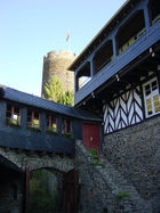
Burg Bischofstein
Encyclopedia
| Picture | Map |
|---|---|
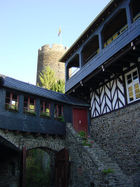 |
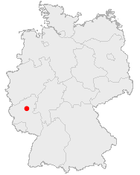 |
| Information | |
| State States of Germany Germany is made up of sixteen which are partly sovereign constituent states of the Federal Republic of Germany. Land literally translates as "country", and constitutionally speaking, they are constituent countries... : |
Rhineland-Palatinate Rhineland-Palatinate Rhineland-Palatinate is one of the 16 states of the Federal Republic of Germany. It has an area of and about four million inhabitants. The capital is Mainz. English speakers also commonly refer to the state by its German name, Rheinland-Pfalz .... |
| County County A county is a jurisdiction of local government in certain modern nations. Historically in mainland Europe, the original French term, comté, and its equivalents in other languages denoted a jurisdiction under the sovereignty of a count A county is a jurisdiction of local government in certain... : |
Mayen-Koblenz Mayen-Koblenz Mayen-Koblenz is a district in the north of Rhineland-Palatinate, Germany. Neighboring districts are Ahrweiler, Neuwied, Westerwaldkreis, district-free Koblenz, Rhein-Lahn, Rhein-Hunsrück, Cochem-Zell, and Vulkaneifel.... |
| Geographic Position: | 50°12′49"N 7°23′2"E |
| Owner: | Verein zur Förderung des Fichte-Gymnasiums Krefeld und des Schullandheims Burg Bischofstein e. V. |
| Address of Owner: | Lindenstr. 52, 47798 Krefeld Krefeld Krefeld , also known as Crefeld until 1929, is a city in North Rhine-Westphalia, Germany. It is located northwest of Düsseldorf, its centre lying just a few kilometres to the west of the River Rhine; the borough of Uerdingen is situated directly on the Rhine... |
| Burg Address: | Schullandheim Burg Bischofstein 56332 Hatzenport Hatzenport Hatzenport is a municipality in the district of Mayen-Koblenz in Rhineland-Palatinate, western Germany.... |
| Website: | www.fichte.de Menüpunkt Burg Bischofstein |
Burg (Castle) Bischofstein is a castle on the Moselle in Germany
Germany
Germany , officially the Federal Republic of Germany , is a federal parliamentary republic in Europe. The country consists of 16 states while the capital and largest city is Berlin. Germany covers an area of 357,021 km2 and has a largely temperate seasonal climate...
. The castle sits between Moselkern and Hatzenport and across from the borough of Burgen. It was a stronghold belonging to the Archbishops of Treves. A characteristic attribute of the castle are its tall cylindrical donjon tower
Keep
A keep is a type of fortified tower built within castles during the Middle Ages by European nobility. Scholars have debated the scope of the word keep, but usually consider it to refer to large towers in castles that were fortified residences, used as a refuge of last resort should the rest of the...
girt round with a white plaster
Plaster
Plaster is a building material used for coating walls and ceilings. Plaster starts as a dry powder similar to mortar or cement and like those materials it is mixed with water to form a paste which liberates heat and then hardens. Unlike mortar and cement, plaster remains quite soft after setting,...
streak about halfway up and the ruined chapel adjoining it.
The castle was built in 1270, destroyed in 1689 and rebuilt again in 1930. It was purchased in 1954 by Fichte Gymnasium in Krefeld, Germany and currently serves as the school's retreat center.
Geography

Burgen, Mayen-Koblenz
Burgen is a municipality in the district of Mayen-Koblenz in Rhineland-Palatinate, western Germany....
about halfway up a steep mountainside. The German public highway B 416 runs below the Burg. This section of the road is also called Moselschieferstrasse. The closest large cities are Cochem
Cochem
Cochem is the seat of and the biggest place in the Cochem-Zell district in Rhineland-Palatinate, Germany. With just under 5,000 inhabitants, Cochem falls just behind Kusel, in the like-named district, as Germany's second smallest district seat...
, which lies about 25 km up the Moselle, and Koblenz
Koblenz
Koblenz is a German city situated on both banks of the Rhine at its confluence with the Moselle, where the Deutsches Eck and its monument are situated.As Koblenz was one of the military posts established by Drusus about 8 BC, the...
, which lies about 35 km downriver.
To the north of the castle lies the plateau
Plateau
In geology and earth science, a plateau , also called a high plain or tableland, is an area of highland, usually consisting of relatively flat terrain. A highly eroded plateau is called a dissected plateau...
of Maifeld
Maifeld
Maifeld is a Verbandsgemeinde in the district Mayen-Koblenz, in Rhineland-Palatinate, Germany. It is situated south-east of Mayen, and west of Koblenz. The seat of the municipality is in Polch....
. The Baybach River, which carves gorges
Gorges
Gorges, the plural of the French word for "throat", usually refers to a canyon.Gorges is the name or part of the name of several communes in France:* Gorges, in the Loire-Atlantique département* Gorges, in the Manche département...
into the Hunsrück
Hunsrück
The Hunsrück is a low mountain range in Rhineland-Palatinate, Germany. It is bounded by the river valleys of the Moselle , the Nahe , and the Rhine . The Hunsrück is continued by the Taunus mountains on the eastern side of the Rhine. In the north behind the Moselle it is continued by the Eifel...
region of Rhineland-Palatinate
Rhineland-Palatinate
Rhineland-Palatinate is one of the 16 states of the Federal Republic of Germany. It has an area of and about four million inhabitants. The capital is Mainz. English speakers also commonly refer to the state by its German name, Rheinland-Pfalz ....
, flowing into the Moselle across from Burg Bischofstein. The neighboring areas of Moselkern and Hatzenport are typical wine villages along the Moselle. Moselkern lies at the mouth of the Elzbach
Elzbach
The Elzbach is a small river in Rhineland-Palatinate, Germany, a left tributary of the Moselle. It rises in the Eifel, near Kelberg. The Elz flows through Monreal and along the castle Burg Eltz. It flows into the Moselle in Moselkern, in the Verbandsgemeinde of Treis-Karden....
river, in the valley of which lies Burg Eltz
Burg Eltz
Burg Eltz is a medieval castle nestled in the hills above the Moselle River between Koblenz and Trier, Germany. It is still owned by a branch of the same family that lived there in the 12th century, 33 generations ago. The Rübenach and Rodendorf families' homes in the castle are open to the...
. The wine makers of Hatzenport make a wine called Burg Bischofstein.
The Castle of the Holy Bishop Nicetius
Folk tales and old Moselle-area historiographies allege that Burg Bischofstein began as the palace for the Holy Bishop Nicetius (527-566). These tales are based upon a poem by Bishop Venantius FortunatusVenantius Fortunatus
Venantius Honorius Clementianus Fortunatus was a Latin poet and hymnodist in the Merovingian Court, and a Bishop of the early Catholic Church. He was never canonised but was venerated as Saint Venantius Fortunatus during the Middle Ages.-Life:Venantius Fortunatus was born between 530 and 540 A.D....
(530-~600), who traveled through the Rhine and Moselle regions with East Frankish King Chilbert around the year 566.
In the 22-verse comprehensive poem, which is entitled "De castello nicetil espiscopi Trevirensis super Mosellam", Fortunas describes the magnificent Castle of Nicetius as having 30 towers, a palace with marble
Marble
Marble is a metamorphic rock composed of recrystallized carbonate minerals, most commonly calcite or dolomite.Geologists use the term "marble" to refer to metamorphosed limestone; however stonemasons use the term more broadly to encompass unmetamorphosed limestone.Marble is commonly used for...
columns and a mighty tower protecting it from across the Moselle.
One clue that the castle described in the poem is actually Burg Bishofstein comes from a torn piece of parchment written by historian Browner in 1670 which references the poem's title "De castello Bischofstein super Mosellam aB. Nicetio extrueto". The validity of this parchment was already being debated in the mid 18th century by historian and auxiliary bishop Johann Nikolaus von Hontheim
Johann Nikolaus von Hontheim
Johann Nikolaus von Hontheim was a German historian and theologian. He is remembered as Febronius, the pseudonym under which he wrote his 1763 treatise On the State of the Church and the Legitimate Power of the Roman Pontiff which offered Europe the "foremost formulation of the arguments against...
. The actual location of the Castle of Nicetius is unknown, but it is accepted that it is somewhere in the Kobern region of Germany. In any case, it is no longer accepted as the precursor for Burg Bischofstein.
1270 to 1824
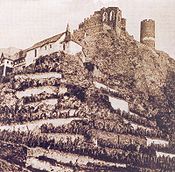
Archdeacon
An archdeacon is a senior clergy position in Anglicanism, Syrian Malabar Nasrani, Chaldean Catholic, and some other Christian denominations, above that of most clergy and below a bishop. In the High Middle Ages it was the most senior diocesan position below a bishop in the Roman Catholic Church...
of Trier Heinrich von Bolanden, who is documented as completing the construction of Burg Bischofstein. This comes from a document dated June 10, 1242 in which von Bolanden promised to replace the Monasteries of Laach and Rumerdorf Schulden. This document was approved by Pope Innocent IV himself on October 29, 1246.
The original builders are unknown. It is known, however, that Heinrich von Bolanden bought the half-completed Burg and paid for the rest of the construction himself. This is confirmed in a document dated September 11, 1273. In this document, von Bolanden bequeathed the completed Burg Bischofstein unto the Church of Trier
Trier
Trier, historically called in English Treves is a city in Germany on the banks of the Moselle. It is the oldest city in Germany, founded in or before 16 BC....
. The conditions of the bestowal were such that he and all subsequent holders of his office would have a lifelong abode and that they should keep feudal responsibility over the Burg. As a reward for von Bolanden all of the then accepted feudal duties were fulfilled.
His successor Hermann von Weilnau granted Arch Bishop Peter von Nassau the fee-simple to Burg Bischofstein in 1303. In the event of war, Burg Bischofstein was at the Arch Bishop's disposal. Heinrich von Pfaffendorf, the third Archdeacon of Bischofstein, pledged in 1329 that:
- he would not tolerate any enemies of the Archbishop at the Burg
- he would protect the section of the Moselle above which the Burg stood
- he would not accommodate any vassals at the Burg without the approval of the Arch Bishop.
Other successors were Gottfried von Brandenburg and Friedrich Pfalzgraf bei Rhein. After 1501 there is no record of investiture
Investiture
Investiture, from the Latin is a rather general term for the formal installation of an incumbent...
.
It is said that in 1552 Markgraf Albrecht von Brandenburg attempted, without success, to besiege Bischofstein. This is, however, undocumented.
The Thirty Years' War
Thirty Years' War
The Thirty Years' War was fought primarily in what is now Germany, and at various points involved most countries in Europe. It was one of the most destructive conflicts in European history....
negatively affected the Moselle. For example, on October 26, 1631, Louis XIV left the nearby village of Münstermaifeld destroyed. Despite this, a detailed visitor log in the Burg's chapel
Chapel
A chapel is a building used by Christians as a place of fellowship and worship. It may be part of a larger structure or complex, such as a church, college, hospital, palace, prison or funeral home, located on board a military or commercial ship, or it may be an entirely free-standing building,...
from 1680 indicates that Burg Bischofstein endured the war without damage. In 1688, during the War of the Grand Alliance
War of the Grand Alliance
The Nine Years' War – often called the War of the Grand Alliance, the War of the Palatine Succession, or the War of the League of Augsburg – was a major war of the late 17th century fought between King Louis XIV of France, and a European-wide coalition, the Grand Alliance, led by the Anglo-Dutch...
, Louis XIV sent troops to weaken the Palatinate following its refusal to ratify the Truce of Regensburg
Regensburg
Regensburg is a city in Bavaria, Germany, located at the confluence of the Danube and Regen rivers, at the northernmost bend in the Danube. To the east lies the Bavarian Forest. Regensburg is the capital of the Bavarian administrative region Upper Palatinate...
. These French troops succeeded in destroying Burg Bischofstein in 1689.
In 1794 the French annexed part of the Rhineland and the French regime liquidated many of the Church's possessions because they were seen as French national property. The ruins of Burg Bischofstein, which at that time belong to the St. Castor monastery in Karden
Treis-Karden
Treis-Karden is an Ortsgemeinde – a municipality belonging to a Verbandsgemeinde, a kind of collective municipality – in the Cochem-Zell district in Rhineland-Palatinate, Germany. It is the seat of the like-named Verbandsgemeinde to which it also belongs...
, were treated as such. They were sold at a state auction to the winemaker Nicolaus Artz on September 29, 1803.
In 1824 it was reported that a house with seven inhabitants was built at the site of the ruins. After this the ownership of the ruins is unknown.
1880 to today
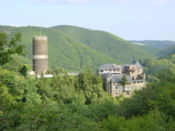
Rheinberg
Rheinberg is a town in the district of Wesel, in North Rhine-Westphalia, Germany. It is situated on the left bank of the Rhine, approx. north of Moers and south of Wesel....
. On 11 April 1930 the heirs sold the castle to a businessman from Darmstadt
Darmstadt
Darmstadt is a city in the Bundesland of Hesse in Germany, located in the southern part of the Rhine Main Area.The sandy soils in the Darmstadt area, ill-suited for agriculture in times before industrial fertilisation, prevented any larger settlement from developing, until the city became the seat...
named Erich Deku, who wanted to rebuild the castle for use as a summer home. It was not reconstructed, but used the preserved walls newly erected. In order to achieve this, builders had to create a pathway for construction vehicles. This partly required rock blasting. Deku furnished the Burg with an extensive art collection. Below the castle, he discovered a polyptych
Polyptych
A polyptych generally refers to a painting which is divided into sections, or panels. The terminology that follows is in relevance to the number of panels integrated into a particular piece of work: "diptych" describes a two-part work of art; "triptych" describes a three-part work; "tetraptych"...
from 1530.
The reconstruction that stands today was completed by the Neuerburg family from Trier
Trier
Trier, historically called in English Treves is a city in Germany on the banks of the Moselle. It is the oldest city in Germany, founded in or before 16 BC....
in 1938. Aenny Neuerburg bought the Burg at auction when bankruptcy proceedings against Deku were opened in 1936. The entire art collection was included in the offer.
From 1941 to 1946 the Burg served as a sanitorium for soldiers and as a hospital and refugee
Refugee
A refugee is a person who outside her country of origin or habitual residence because she has suffered persecution on account of race, religion, nationality, political opinion, or because she is a member of a persecuted 'social group'. Such a person may be referred to as an 'asylum seeker' until...
safehouse under the leadership of Aenny Neuerburg. Mrs. Neuerburg's son Raymond then took over the leadership position and with his family operated a hostel
Hostel
Hostels provide budget oriented, sociable accommodation where guests can rent a bed, usually a bunk bed, in a dormitory and share a bathroom, lounge and sometimes a kitchen. Rooms can be mixed or single-sex, although private rooms may also be available...
for foreigners. After Aenny's death the Neuerburg family put the Burg up for sale.
On 29 June 1954 the Schullandheimverein (association for the construction of a school retreat center) of Fichte Gymnasium in Krefeld bought the Burg for only 80,000 DM (about $360,000 today). They then began to construct the retreat center.
Today, Burg Bischofstein is a designated and protected historical spot; not as an 800 year old castle, but as an example of the architectural style of the 1930s.
Burg Bischofstein as a Retreat Center
Every year, Classes 5-9 and 11 from Fichte Gymnasium travel to Burg Bischofstein. Schools all around Germany also visit the Burg. During vacations the Burg is used predominantly by vacationing groups. Class reunions are also held there. A stay at the castle is a special experience for exchange students from many different countries.Background
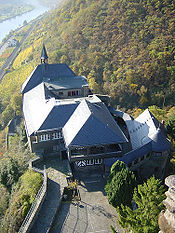
On 29 June 1954 the executor of the late Mrs. Neuerburg's will approved the purchase of Burg Bischofstein. The transfer of ownership took place on 1 July 1954. The very same year, with great effort, the most basic facilities were purchased and the bedrooms, living rooms and the kitchen were renovated and equipped. The first visitors of the Burg were members of the 12th grade because several of the students had shown good technical skills. They painted, performed small repairs, and ensured that the Burg would be prepared for future visits. Since then, students from Fichte Gymnasium have enjoyed the pleasures of staying at Burg Bischofstein.
Until 1980 the Burg was only open to students from Fichte Gymnasium. At the beginning of the 1980s, for financial reasons, the Burg was opened to other schools in Krefeld and then to other groups and schools. Today students from virtually all regions in Germany visit Burg Bischofstein.
In the summer of 2004, the Burg celebrated its 50th year as a retreat center: 50 Jahre Schullandheim Burg Bischofstein.
Use
Today the Burg has a 12-bed dormitoryDormitory
A dormitory, often shortened to dorm, in the United States is a residence hall consisting of sleeping quarters or entire buildings primarily providing sleeping and residential quarters for large numbers of people, often boarding school, college or university students...
and other dormitories, 2 rooms for teachers, a dining/meeting hall, a rec room with foosball and ping-pong tables, a kitchen, and storage rooms. The caretaker
Property caretaker
A Property caretaker is a person, group or organization that cares for real estate for trade or financial compensation, and sometimes as a barter for rent-free living accommodations...
's residence is under the rec room.
Tower
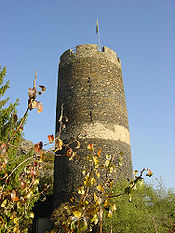
Parapet
A parapet is a wall-like barrier at the edge of a roof, terrace, balcony or other structure. Where extending above a roof, it may simply be the portion of an exterior wall that continues above the line of the roof surface, or may be a continuation of a vertical feature beneath the roof such as a...
which was destroyed by fire in 1689 and so burned itself into the wall of the tower.
Renovation
In 1997 the tower underwent a renovation. The battlements were newly reinforced and the tower platform was completely reconstructed. Wooden steps were constructed inside the tower in the architectural style of the Middle Ages and today, visitors to Burg Bischofstein can climb to the top of the tower and enjoy the beautiful view of the Moselle Valley. The city flag of KrefeldKrefeld
Krefeld , also known as Crefeld until 1929, is a city in North Rhine-Westphalia, Germany. It is located northwest of Düsseldorf, its centre lying just a few kilometres to the west of the River Rhine; the borough of Uerdingen is situated directly on the Rhine...
flies at the tower summit.
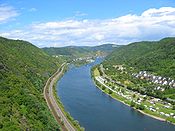
Stories about the Tower
Through history, many tales have been spun about the tower and its white ring. One explains that bands of robbers regularly attacked tradesmen on the trade route that the Burg protected. To put and end to this, Bischof von Trier put the ring around the tower, and said that every captured robber would be then hanged from it to demonstrate to others what would become of those of this kind”.Another story claims that there was a huge flood
Flood
A flood is an overflow of an expanse of water that submerges land. The EU Floods directive defines a flood as a temporary covering by water of land not normally covered by water...
and the ring marks the high water mark, while another version asserts that Bischof von Trier once freed the tower's Lord from the flood. To thank him for this, the Lord fixed the ring to the tower as a symbol of the "Bischof's ring" and at the flood level of the Moselle.
Literature
- Flo, Winfried Schorre: Burg Bischofstein an der Mosel. Görres-Druckerei GmbH und Verlag, Koblenz 2002, ISBN 3-935690-02-9
External links
Pictures:Information:
- Entry about the Burg in the Scholarly Castle Databank of the European Institute of Castles (In German) Click on "Deutschland" and search for "Bischofstein"
- Information about the Burg
- Site des Fichte-Gymnasiums (link to Burg Bischofstein)
- Ehemaligenverein des Fichte-Gymnasiums Krefeld e. V.

